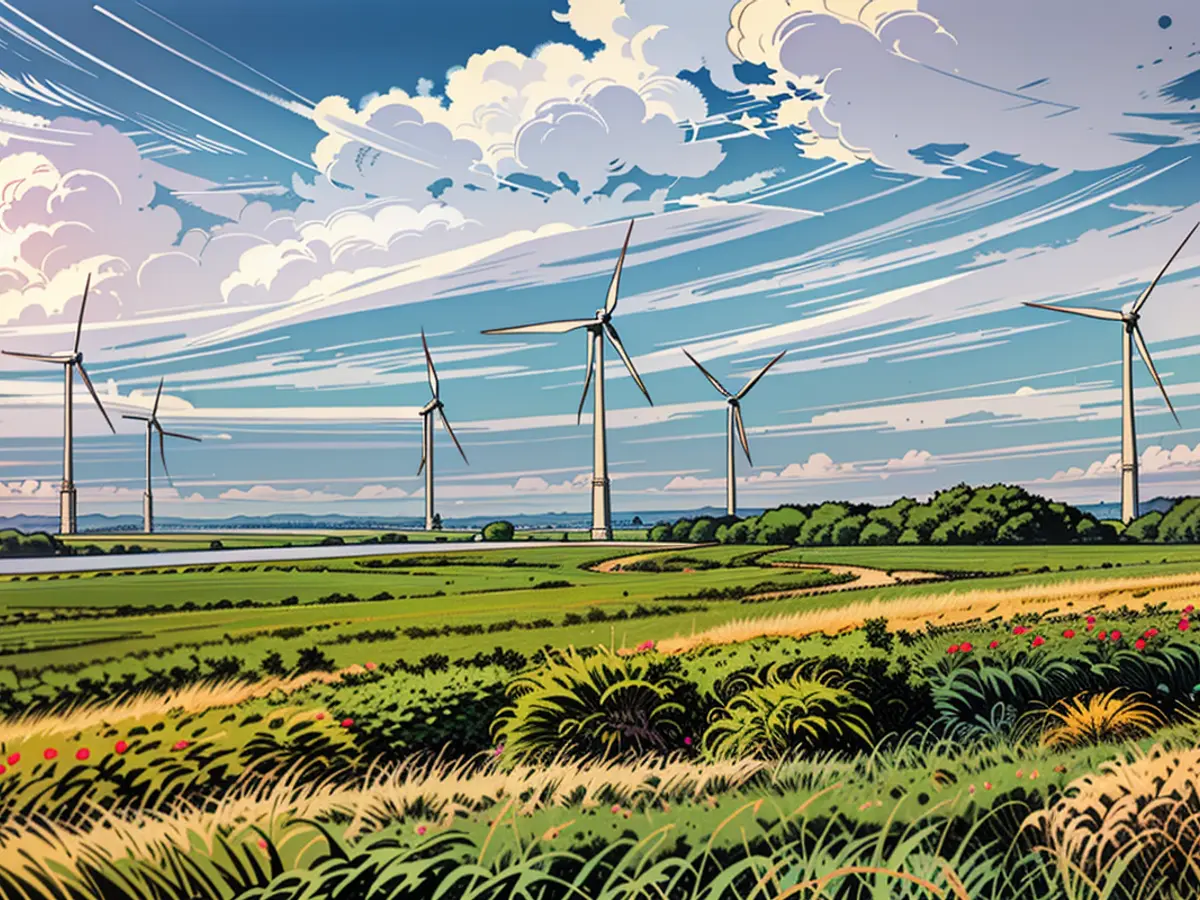Renewable Energy - Fewer tempo in the construction of new wind turbines
The expansion of wind energy experienced a slight setback in the first half of the year. Nationwide, 250 new wind turbines with a total capacity of approximately 1.3 Gigawatts were built - a 19% decrease compared to the previous year's period. The number of newly authorized wind turbines that have not been realized yet, however, increased by 32% to 847.
Heidebroek, President of the German Wind Energy Association (Bundesverband Windenergie), emphasized the positive development and stated that there is great potential for expansion. She referred to the challenges in the first half of the year, which included unusually strong winds in April that prevented cranes from being erected and caused technical issues on construction sites. Additionally, there were problems with the transport of rotor blades due to a closure on the A27 autobahn near Cuxhaven. Most rotor blades for wind turbines come through this harbor and are then transported to the interior of the country.
Heidebroek also mentioned the strong north-south divide in the land-based wind energy expansion. Most new installations were built in North Rhine-Westphalia, followed by Lower Saxony and Schleswig-Holstein. In contrast, Baden-Württemberg and Bavaria contributed only marginally to the expansion. The south must catch up and designate areas, she said. "The bottleneck are still the areas."
As of the end of the first half of the year, a total of 28,611 wind turbines with a total capacity of 61.9 Gigawatts had been installed nationwide. The federal government's goal is a total capacity of 115 Gigawatts by 2030. The current expansion is behind schedule according to industry estimates. To make up for the necessary catch-up, implemented projects need to be expedited. Even if the federal government makes decisions, such as shortening planning and approval procedures, further political measures are necessary.
The industry had predicted a build-out of 4 Gigawatts for the entire year 2024. To achieve this, a push is needed, said Dennis Rendschmidt, Managing Director of VDMA Power Systems. He spoke about the numbers for the first half of the year with a look towards the light and shadow.
Simplification and acceleration of approval procedures for large-scale and heavy transport are necessary, according to Rendschmidt. "To get the components of wind energy systems to the construction sites as smoothly as possible, it requires uniform federal regulations."
Uncertainty over further funding
There is to be a system change in the expansion of renewable energy from wind and solar. The federal government plans to switch to an investment cost subsidy, as part of the "Growth Initiative." So far, onshore wind energy has had tenders, with operators bidding for a funding level - instead of receiving a legally fixed feed-in tariff as before. Heidebroek stated that a complete shift of the funding system could unsettle the industry, investments could be withheld.
Financial participation of municipalities
Heidebroek also emphasized the importance of municipal financial participation in the expansion of wind energy. She pointed out that many wind farms are located on communal land and that the municipalities could benefit financially from this. She called for a more active role for municipalities in the expansion of wind energy. "The municipalities are not only those affected, but also those who can benefit financially."
After the Renewable Energy Law, operators of wind energy power plants are supposed to offer financial participation to the local communities. This is a voluntary regulation. Communities can then directly profit from the electricity revenues of wind turbines in their vicinity. According to the Bundesverband der Energie- und Wasserwirtschaft (Federal Association of Energy and Water Industries), wind park operators, including the companies EWE, EnBW and Enertrag, have committed to this financial participation of communities. The additional income for the communities ranges from 20,000 to 30,000 Euro per year per wind energy plant. These additional income sources could be invested by the communities in important local projects.
BDEW CEO Kerstin Andreae named this self-commitment an important step to strengthen sustainable development in rural areas and at the same time to further promote acceptance and support for wind energy projects on land.
- The setback in wind energy expansion only affected the first half of the year, with 250 new wind turbines producing 1.3 Gigawatts, a 19% decrease from the previous year.
- The challenges in the first half included strong winds in April, technical issues on construction sites, and a closure on the A27 autobahn near Cuxhaven, affecting rotor blade transport.
- Most wind turbine installations occurred in North Rhine-Westphalia, Lower Saxony, and Schleswig-Holstein, while Baden-Württemberg and Bavaria lagged behind in expansion.
- Germany's federal government aims for a total wind energy capacity of 115 Gigawatts by 2030, with current expansion lagging behind.
- The industry originally predicted a 4 Gigawatt build-out for the entire 2024, requiring a push to meet this goal.
- Simplification and acceleration of approval procedures and uniform federal regulations are necessary for transportation of wind energy systems' components.
- Switching to an investment cost subsidy as part of the "Growth Initiative" could unsettle the industry, withholders of investments, according to Heidebroek.
- Municipal financial participation in wind energy expansion is crucial, said Heidebroek, pointing out that many wind farms are on communal land, and municipalities could benefit financially.
- Operators of wind energy power plants are expected to offer financial participation to local communities under the Renewable Energy Law, allowing direct profits for communities.
- EWE, EnBW, and Enertrag are among the companies that have committed to financial participation, potentially providing communities with 20,000 to 30,000 Euros in annual income from each wind energy plant.
- This commitment supports sustainable development in rural areas, further promoting acceptance of land-based wind energy projects, according to BDEW CEO Kerstin Andreae.








